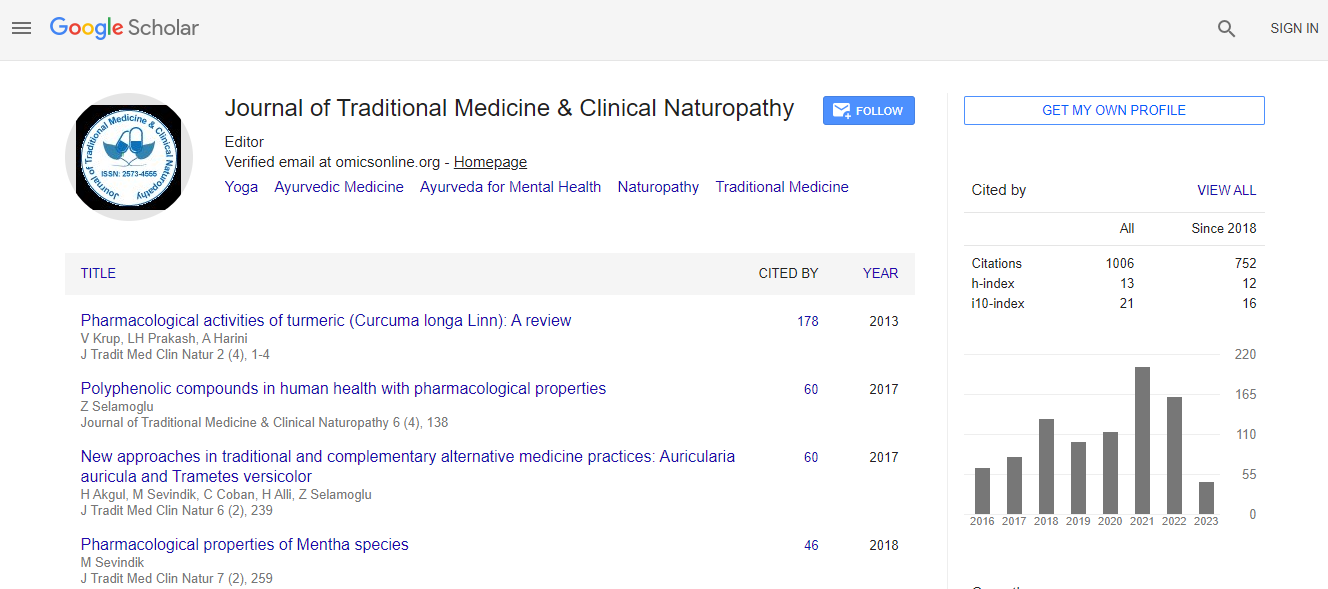Our Group organises 3000+ Global Conferenceseries Events every year across USA, Europe & Asia with support from 1000 more scientific Societies and Publishes 700+ Open Access Journals which contains over 50000 eminent personalities, reputed scientists as editorial board members.
Open Access Journals gaining more Readers and Citations
700 Journals and 15,000,000 Readers Each Journal is getting 25,000+ Readers
Google Scholar citation report
Citations : 1504
Journal of Traditional Medicine & Clinical Naturopathy peer review process verified at publons
Indexed In
- CAS Source Index (CASSI)
- Google Scholar
- Sherpa Romeo
- Open J Gate
- Genamics JournalSeek
- RefSeek
- Directory of Research Journal Indexing (DRJI)
- Hamdard University
- EBSCO A-Z
- Publons
- Geneva Foundation for Medical Education and Research
- Euro Pub
- ICMJE
Useful Links
Recommended Journals
Related Subjects
Share This Page
TLC plants fingerprinting of two aqueous herbal products
Joint Event on Global Summit on Traditional & Restorative Medicine & 10th World Congress on Neuropharmacology
Ezekiel O Afolabi
University of Jos, Nigeria
ScientificTracks Abstracts: J Tradit Med Clin Natur
Abstract
As herbal medicines are becoming commercialized, the safety, quality and efficacy of herbal products have become a great concern to the pharmacy world and in order to ensure this, an optimized standardization method is needed. In view of this, a review on plant fingerprinting was carried out using the systematic review methods indicating regions of the world where most of the studies have been carried out. Years of studies and various analytical techniques or methods were used to identify the plants and their common metabolites. Results indicated genetic, chemical and morphological fingerprint as the major types highlighting genetic fingerprint as the most common type of plants fingerprint applied technique. Other individual types of genetic fingerprints such as SSR were indicated as the common types, so also for chemicals, HPTLC are used as the most common types. Regions like Asia have carried out studies on plant fingerprinting and most of these studies were carried out in recent years within the 2014 and 2018. In an attempt to show that analytical methods used in plant fingerprinting are not novel standardization techniques or procedures, two herbal products like sample D1 and D2 were purchased from the open markets and the herbal concoctions were meant to be used for erectile dysfunctions, using TLC fingerprinting techniques, where D1 and D2 are proposed to be the same. Further detailed investigation using LC-MS was done to characterize the major components in the herbal concoctions and phytochemical analysis shows that saponins, alkaloids and tannins are present in the productsBiography
Ezekiel O Afolabi is currently working in the Dept. of Pharmaceutical Chemistry, University of Jos at Nigeria. His research interests are medicinal plants, chromatography and herbal medicine etc.
E-mail: afolabie52@gmail.com

 Spanish
Spanish  Chinese
Chinese  Russian
Russian  German
German  French
French  Japanese
Japanese  Portuguese
Portuguese  Hindi
Hindi 
